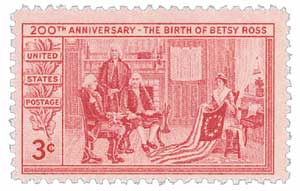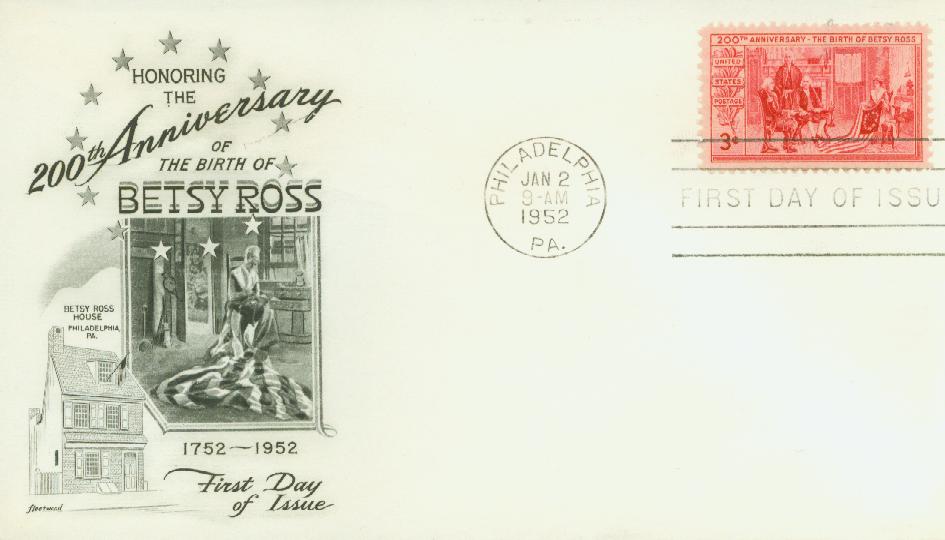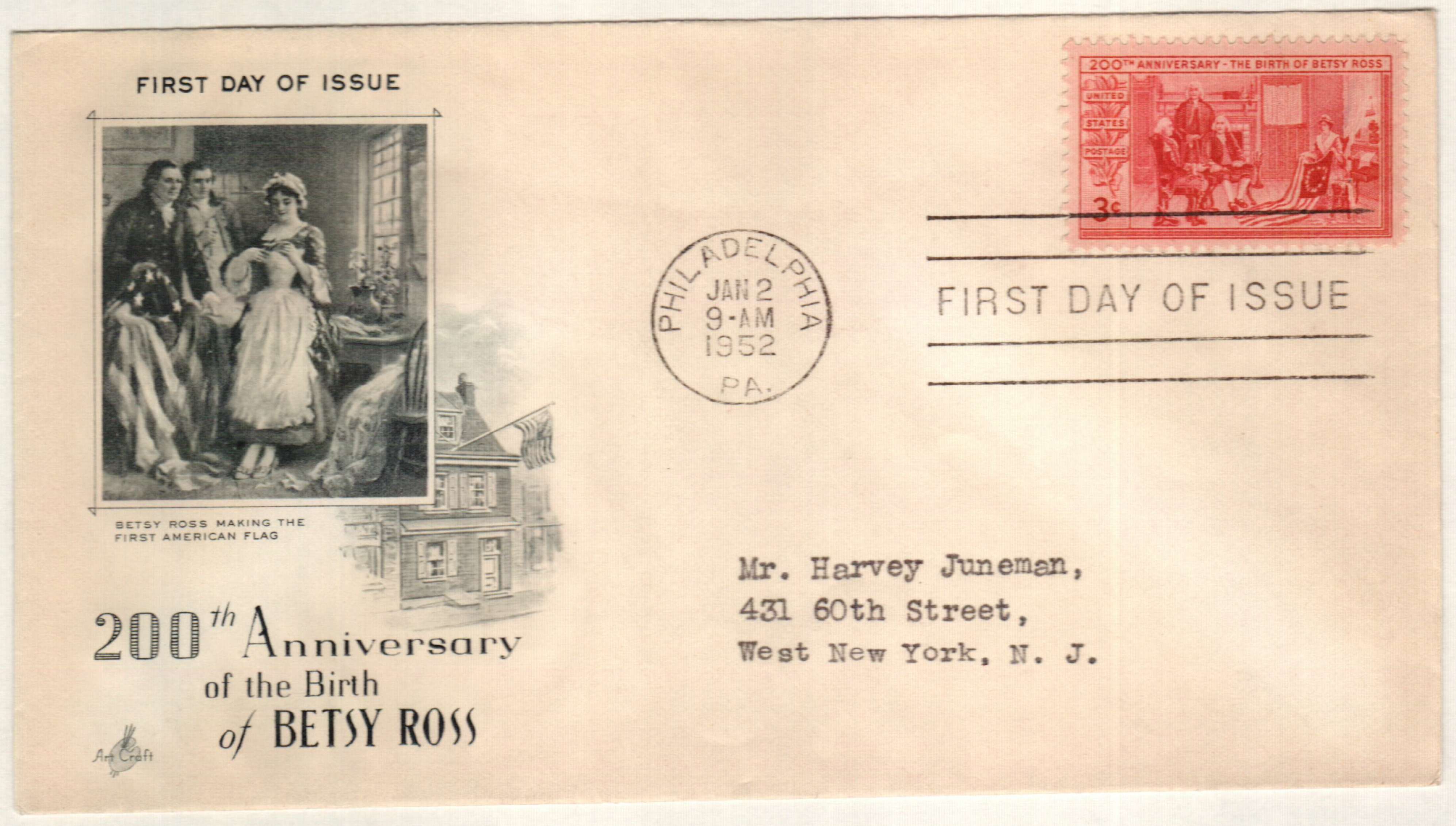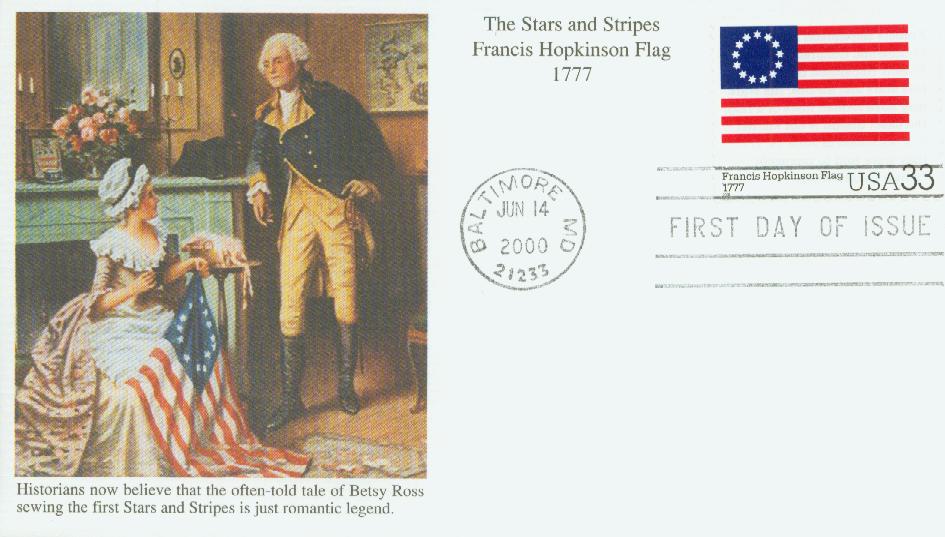
# 3403e FDC - 2000 33c The Stars and Stripes: Francis Hopkinson Flag
33¢ Francis Hopkinson Flag (1777)
The Stars and Stripes
City: Baltimore, MD
Quantity: 4,000,000
Printed by: Banknote of America
Printing Method: Lithographed
Perforations: 10.5 x 11
Color: Multicolored
Betsy Ross Stamp

On January 2, 1952, the US Post Office Department issued a commemorative stamp honoring Betsy Ross, one day after her 200th birthday.
Elizabeth Griscom “Betsy” Ross was born on January 1, 1752, in Philadelphia, Pennsylvania. The eighth of seventeen children, Betsy was raised in a Quaker household and learned to sew from her great-aunt.

After attending school, Betsy became an apprentice to an upholsterer, where she met and fell in love with John Ross. The couple eloped and she was expelled from the church. They then started their own upholstery business where they reportedly befriended George Washington.

When the war began, Betsy’s husband was killed, possibly in a gunpowder explosion. Betsy continued the upholstery business and was kept busy making tents and blankets and repairing uniforms. She was also the official flag maker of the Pennsylvania Navy. Betsy married twice in the following years (her second husband was imprisoned in England) and had seven children.
After the war, Betsy continued with her upholstery business in Philadelphia. She retired in 1827 and spent her final years with her children. She died on January 30, 1836.
The tale of the Betsy Ross flag was generally unknown prior to 1870. That was when William Canby first told the Pennsylvania Historical Society of his grandmother’s place in our flag’s creation.
According to Canby, back in 1776, General George Washington came to Ross’ upholstery shop to commission a flag based on a rough design. Ross made some adjustments (including changing the number of points on the stars) and sewed the original Stars and Stripes. It was this flag that was presented to Congress and confirmed as the nation’s emblem.

With no actual records and nothing but hearsay to go on, Canby was largely disbelieved. But by 1873, his story was running in Harper’s Weekly. The audience grew significantly, as did belief.
Other descendants of Betsy Ross have continued the legend, and even embellished a little. And supporters are always looking for historical evidence to prove the story. But today, it is often dismissed as a myth or considered a fable.

What was once known as the Betsy Ross flag is now called the Francis Hopkinson flag, after the member of the Continental Congress whose claims date back to the Revolutionary era and are considered more credible.
When the Betsy Ross stamp was issued in 1952, the legend of the Betsy Ross flag was still commonly accepted as history. The stamp design was based on a painting by Charles H. Weisgerber that pictures Betsy Ross showing the flag to the Flag Committee – General George Washington, Robert Morris, and George Ross.
33¢ Francis Hopkinson Flag (1777)
The Stars and Stripes
City: Baltimore, MD
Quantity: 4,000,000
Printed by: Banknote of America
Printing Method: Lithographed
Perforations: 10.5 x 11
Color: Multicolored
Betsy Ross Stamp

On January 2, 1952, the US Post Office Department issued a commemorative stamp honoring Betsy Ross, one day after her 200th birthday.
Elizabeth Griscom “Betsy” Ross was born on January 1, 1752, in Philadelphia, Pennsylvania. The eighth of seventeen children, Betsy was raised in a Quaker household and learned to sew from her great-aunt.

After attending school, Betsy became an apprentice to an upholsterer, where she met and fell in love with John Ross. The couple eloped and she was expelled from the church. They then started their own upholstery business where they reportedly befriended George Washington.

When the war began, Betsy’s husband was killed, possibly in a gunpowder explosion. Betsy continued the upholstery business and was kept busy making tents and blankets and repairing uniforms. She was also the official flag maker of the Pennsylvania Navy. Betsy married twice in the following years (her second husband was imprisoned in England) and had seven children.
After the war, Betsy continued with her upholstery business in Philadelphia. She retired in 1827 and spent her final years with her children. She died on January 30, 1836.
The tale of the Betsy Ross flag was generally unknown prior to 1870. That was when William Canby first told the Pennsylvania Historical Society of his grandmother’s place in our flag’s creation.
According to Canby, back in 1776, General George Washington came to Ross’ upholstery shop to commission a flag based on a rough design. Ross made some adjustments (including changing the number of points on the stars) and sewed the original Stars and Stripes. It was this flag that was presented to Congress and confirmed as the nation’s emblem.

With no actual records and nothing but hearsay to go on, Canby was largely disbelieved. But by 1873, his story was running in Harper’s Weekly. The audience grew significantly, as did belief.
Other descendants of Betsy Ross have continued the legend, and even embellished a little. And supporters are always looking for historical evidence to prove the story. But today, it is often dismissed as a myth or considered a fable.

What was once known as the Betsy Ross flag is now called the Francis Hopkinson flag, after the member of the Continental Congress whose claims date back to the Revolutionary era and are considered more credible.
When the Betsy Ross stamp was issued in 1952, the legend of the Betsy Ross flag was still commonly accepted as history. The stamp design was based on a painting by Charles H. Weisgerber that pictures Betsy Ross showing the flag to the Flag Committee – General George Washington, Robert Morris, and George Ross.














